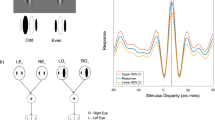Abstract
In order to estimate objectively binocular vision and especially stereopsis, random dot stereograms generated by a personal computer were used. Brain activity during stereopsis was topographically studied by visually evoked potentials (VEPs). The potentials evoked by binocular viewing of patterns without disparity, e.g. correlogram, were very similar to the potentials evoked from patterns with disparity, i.e. stereogram, as many authors have already indicated. To derive the stereo-related potentials from the VEP elicited by stereograms, the potentials evoked by correlograms were subtracted from the potentials evoked by stereograms, and the differences of topographical distribution between normal and stereoblind subjects were investigated.
Similar content being viewed by others
References
Fukai S (1985) Topographic visually evoked potentials induced by stereoptic stimulus. Br J Ophthalmol 69: 612–617
Herpers MJ, Caberg HB and Mol JMF (1981) Human cerebral potentials evoked by moving dynamic random dot stereograms. Electroencephalogr Clin Neurophysiol 52: 50–56
Julesz B (1960) Binocular depth perception of computer generated patterns. Bell System Tech J 39: 1125–1162
Julesz B (1971) Foundations of Cyclopean Perception. Chicago: University of Chicago Press
Julesz B, Kropfl W and Petrig B (1980) Large evoked potentials to dynamic random-dot correlograms and stereograms permit quick determination of stereopsis. Natl Acad Sci USA 77: 2348–2351
Lehmann D, Skrandies W and Lindenmaier C (1978) Sustained cortical potentials evoked in humans by binocularly correlated, uncorrelated and disparate dynamic random-dot stimuli. Neurosci Letters 10: 129–134
Mol J and Caberg H (1977) Contingent stereptic variation as a response to moving random dot stereograms. Electroencephalogr Clin Neurophysiol 43: 513
Omoto T, Hatsukawa Y and Murai Y (1984) VEPs in binocular disparate stimulation with dynamic random-dot patterns. Jpn J Ophthalmol 88: 559–564
Poggio GF and Fischer B (1977) Binocular interaction and depth sensitivity in striate and prestriate cortex of behaving rhesus monkey. J Neurophysiol 40: 1392–1405
Regan D and Spekreijse H (1970) Electrophysiological correlate of binocular depth perception in man. Nature (London) 225: 92–94
Regan D and Beverly KI (1973) Electrophysiological evidence for existence of neurons sensitive to direction of depth movement. Nature (London) 246: 504–506
Author information
Authors and Affiliations
Rights and permissions
About this article
Cite this article
Yanashima, K., Miwa, M., Akeo, Y. et al. Topographical study of stereo-related potentials. Doc Ophthalmol 65, 25–33 (1987). https://doi.org/10.1007/BF00162717
Issue Date:
DOI: https://doi.org/10.1007/BF00162717




